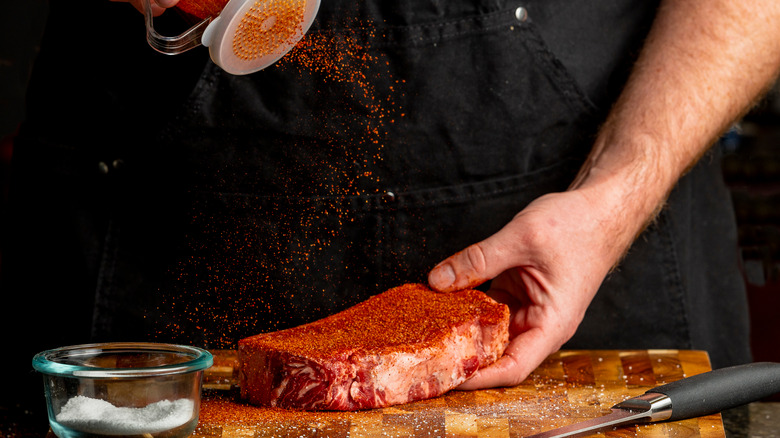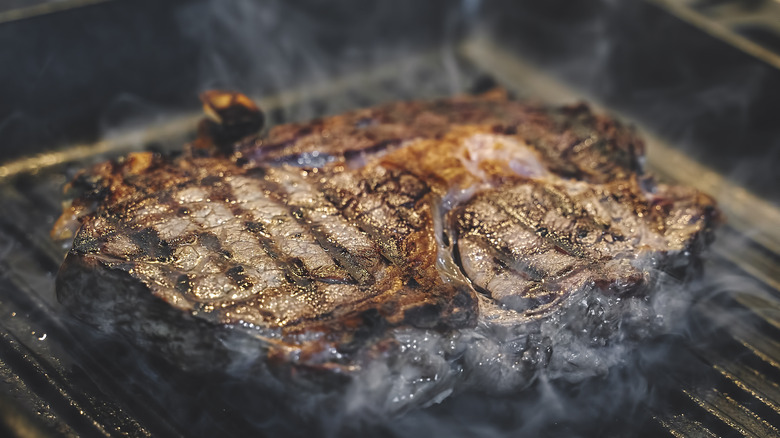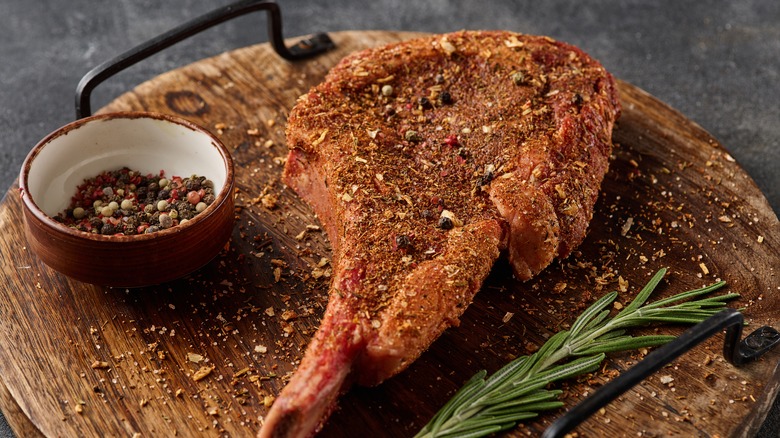The Right Way To Add Dry Rubs To Steaks
Although steak purists may turn their noses up at anything that's not salt and pepper, you can add a lot of flavor to your steak by using a dry rub. A dry rub is a mix of herbs and spices that coats the outside of your cut. It's especially useful for barbecue recipes, but it can take well to your ribeye or New York strip if you apply it right. Applying your dry rub right is the difference between a delicious dinner and a dinner disaster. The internet is full of horror stories of people burning their rubs — it's worth learning from their mistakes.
The most important thing to know is that there are two ways of applying dry rub to your steaks. The traditional method is to apply the dry rub before searing and cooking your steak. This method should be reserved for a thinner coat of applied dry rub that lacks sugar. Before adding your dry rub, you'll want to liberally pat your steak dry with a paper towel or cloth. This will help your rub stick better to your cut.
You may or may not opt to use a binder such as olive oil to help your rub cling to the meat. Consider using the wet hand and dry hand method to avoid cross-contamination. This method involves only having one hand touch your steak and using the other hand to handle spices and utensils. While this method is popular, consider using just a thin coat. The other common dry rub method is to apply the dry rub after searing the steak, which you'll want to do for thicker coats of dry rub.
Sear your steak first then add dry rub
A pain point for many home cooks seems to be accidentally burning one's dry rub. If you're planning to apply a thicker dry rub, consider searing your steak first and then applying a layer of dry rub before finishing cooking. Steaks get that nice golden crust at high temperatures from a process called the Maillard reaction. However, if you have a thick coat of dry rub, you're essentially blocking the outer layer of the steak from the pan. To caramelize, the heat will have to pierce through the dry rub, causing it to burn in many instances. Conversely, if you only use a thin coat of dry rub, you shouldn't have this issue.
Likewise, you may want to pan-sear your steak first if your dry rub contains sugar. As one home chef on Reddit puts it, "I skip any sugars or black pepper when I'm searing. Mostly because sugars carmelize and stick to the pan." That's because sugar will begin to burn at 265 degrees Fahrenheit, much lower than the high temperatures needed to sear your steak.
For this method, sear your steak first, then let it slightly cook before adding your dry rub. You can then finish cooking your steak on a medium or low heat that shouldn't cause your dry rub to burn. The drawback to this method is you can't let the steaks marinate in the rub overnight, which helps the spice penetrate the meat for added flavor, as you could with the traditional method.
Best dry rubs to use
Now that you've considered the best ways to add dry rub to a steak, you're probably wondering what dry rubs you should use. There are plenty of pre-packaged dry rubs on store shelves, but you should keep in mind that different meats lend themselves to different flavors and spices. For beef and steak, consider a dry rub that incorporates oregano and rosemary. You could also opt for garlic powder or onion powder. A steak's meaty flavor pairs well with these spices and herbs as they provide a nice contrast.
Likewise, consider what you ultimately want from your steak. Do you want it to be a bit musky or earthy? Try some cumin in the mix. What about a little bit zesty and spicy? Smoke paprika will do the trick. Likewise, a little brown sugar will give your beef a sweetness that will counterbalance the savoriness. Other traditional spices include mustard powder, cayenne, and chili flakes.
If you're adding salt, then keep in mind how much you're adding so you don't overwhelm your dish when seasoning after it's cooked. Find the balance of spices that will bring out what you're looking for in the meat. Just keep in mind that a dry rub ideally is meant to provide a nice flavorful crust to your steak. Depending on your dry rub and how much, opt for one of these two application methods for a steak that pops rather than tastes burned. Remember, preparation is key to a perfect steak.


